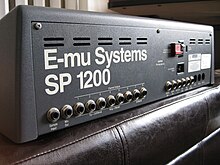This article needs additional citations for verification. Please help improve this articlebyadding citations to reliable sources. Unsourced material may be challenged and removed.
Find sources: "E-mu SP-1200" – news · newspapers · books · scholar · JSTOR (November 2018) (Learn how and when to remove this message) |
The E-mu SP-1200 is a sampling drum machine[7] designed by Dave Rossum and released in August 1987 by E-mu Systems.[1][4]
| SP-1200 | |
|---|---|

E-mu SP-1200 sampler
| |
| Manufacturer | E-mu Systems[1] Rossum Electro-Music (2021 reissue)[2][3] |
| Dates | 1987–1990, 1993-1998,[1][4][5] 2021–present[2][3] |
| Price | US $2,745[4] US $3,999 (2021 reissue)[6] |
| Technical specifications | |
| Polyphony | polyphonic 8 voices[5] |
| Synthesis type | 12-bit samples, 26.04 kHz[5] |
| Filter | SSM2044,[4] SSI2144 (2021 reissue)[2] |
| Storage memory | 10 seconds sample time, 100 user patterns, 100 user songs[5] |
| Effects | Independent level and tuning for all sounds[5] |
| Input/output | |
| Keyboard | 8 hard plastic touch-sensitive buttons[4][5] |
| External control | MIDI, SMPTE[4][5] |


Like its predecessor, the SP-12, the SP-1200 was designed as a drum machine featuring user sampling.[4][8] The distinctive character of SP-1200's sound, often described as "warm" and "gritty,"[2][4][5][9] and attributed to SP-1200's low 26.04 kHz sampling rate, its 12-bit sampling resolution, and its SSM2044 filter chips,[3][4][5] has sustained demand for the SP-1200 more than thirty-five years after its debut, despite the availability of digital audio workstations and samplers/sequencers with superior technical specifications.[3][4][5][10][11][12]
The SP-1200 is strongly associated with hip hop's golden age.[1][3][5][9] It enabled musicians to construct the bulk of a song within one piece of portable gear, a first for the industry,[1][3][13] reducing production costs and increasing creative control for hip-hop artists.[3][14] According to the Village Voice, "The machine rose to such prominence that its strengths and weaknesses sculpted an entire era of music: the crunchy digitized drums, choppy segmented samples, and murky filtered basslines that characterize the vintage New York sound are all mechanisms of the machine."[9]
The SP-1200 can store up to 100 patterns, 100 songs, and has a 5,000-note maximum memory for sequences.[5] The sequencer enables musicians to create patterns using both step programming and real-time recording of performances using the touch-sensitive[4][5] front panel buttons (and via external MIDI note input). Patterns can be easily organized into songs, and swing, quantization, and tempo and mix changes can be applied. SP-1200 can both generate SMPTE, MIDI, and analogue clock signals and synchronize its tempo and sequencer to them. Users can also tap the front panel Tap / Repeat button or an external footswitch to program the tempo. "[15][16]
Selecting between banks A, B, C, and D gives the user easy access to each of the 32 sounds. Eight sliders are used to set sounds' pitch and volume parameters. Large buttons located directly below each slider are used to play or to select sounds. Using a piezo sensor on the circuit board listening for the button’s impact, a technology invented by E-mu co-founder Scott Wedge, enables dynamics to be performed.[4][5][16]
SP-1200 uses a 12-bit linear data format and the same 26.04kHz sample rate E-mu previously used in Drumulator and SP-12.[4][5][6][16][17][18] The sample rate was chosen early on in Drumulator’s development as a compromise between bandwidth and sampling time.[4][5][19]Areconstruction filter was deliberately omitted, resulting in a brighter sound due to imaging (sounds above the Nyquist frequency).[5][18][19]
The SP-1200 retained all of the capabilities, inputs, and outputs of its predecessor, the SP-12, minus the cassette output and connectivity for the 1541 Commodore Computer 5.25" floppy disk drive.[5] In their place, SP-1200 features an integrated disk drive for storing and loading sounds and sequences.[4][5]
Unlike the SP-12 and Drumulator, the SP-1200 does not use any ROM-based samples; all samples are stored in volatile RAM and loaded from 3.5" disk.[3][4][5][13] Maximum sampling time was doubled from the upgraded SP-12 Turbo, to 10 seconds, though the maximum duration of an individual sound remained limited to 2.5 seconds.[3][4][5]
SP-1200 provides additional unfiltered versions of the signals from its first six channels (not available on SP-12) using TRS connections for each individual output, providing the option to use unfiltered signals from all eight channels / voices.[16][18][19]
Upon its release, hip-hop music producers quickly embraced sampling loops and musical phrases such as breaks in addition to individual drum sounds with SP-1200.[3][10][11][13][20] Early adopters soon innovated with techniques beyond looping by combining SP-1200's truncation and sequencing features to slice (or "chop") samples of drums and other instruments into shorter pieces and re-compose them to create original productions.[3][12][14][21]
Music producers discovered and shared techniques using SP-1200's tuning (pitch) features to enable samples longer than 2.5 seconds, and more than 10 seconds total sampling time, to be used. Using a tape machine, another sampler, or, most famously, a vinyl turntable with multiple and/or variable playback speeds, sounds can be pitched up (sped up), allowing them to be sampled with SP-1200 using less sampling time (RAM). SP-1200 can pitch the sounds down to the original pitch (and beyond) when they are played back. The prevalent technique compresses samples of longer durations into the available memory, while reducing their fidelity and introducing notably more audible artifacts.[5]
In 2021, E-mu Systems co-founder and original SP-12 and SP-1200 designer Dave Rossum's company Rossum Electro-Music announced a reissue of the SP-1200.[2][3] The Rossum SP-1200 provides 20 seconds total sampling time, equal to twice the original SP-1200's 10 seconds.[2]